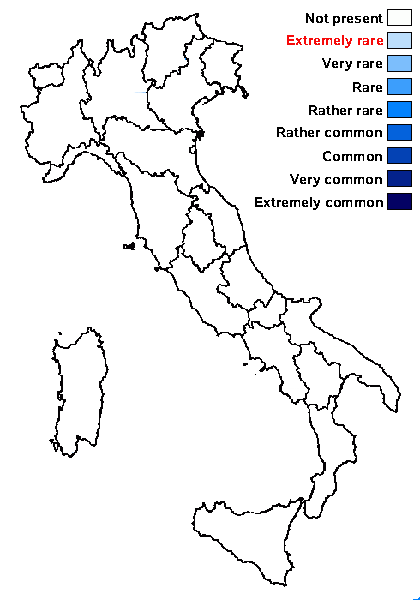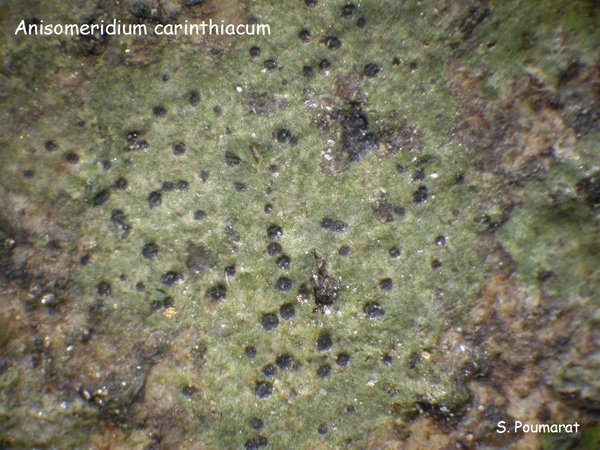Anisomeridium carinthiacum (J. Steiner) R.C. Harris
in Egan, Bryologist, 90, 2: 163, 1987. Basionym: Arthopyrenia carinthiaca J. Steiner - Öst. bot. Z., 63: 335, 1913
Synonyms:
Distribution:
Description: Thallus crustose, whitish to greenish-grey, 30-50 µm thick,ecorticate, paraplectenchymatous, not subgelatinous when wet, without a distinct prothallus. Perithecia black, 50-160 µm across, immersed to semi-immersed, the upper part exposed or covered by a thin thalline layer. Involucrellum present, 130-235 x 45-90 µm, 12-70 µm thick; exciple of cellular hyphae, brown-black in upper part, pale or colourless in lower part; pseudoparaphyses slender, branched and anastomosing, long-celled, c. 1 μm thick; periphyses absent; hymenial gel I-. Asci 8-spored, cylindrical, K/I-, fissitunicate, the apical dome with an indistinct ocular chamber, with biseriately arranged ascospores. Ascospores 1-septate, with equal or slightly unequal cells, hyaline, 9-15 x 3.6-7 µm. Pycnidia unknown. Photobiont trentepohlioid. Spot tests: thallus K-, C-, KC-, P-, UV-. Chemistry: without lichen substances.Note: an apparently rare, amphibious freshwater species growing submerged or slightly above water level on siliceous rocks and pebbles, restricted to shaded sites in upland areas. Known only from a few localities in Germany (Hesse), Austria (Styria, Carinthia), and France (Puy-de-Dôme), the species should be looked for in Italy.
Growth form: Crustose
Substrata: rocks
Photobiont: Trentepohlia
Reproductive strategy: mainly sexual
Periodically submerged (e.g. in creeks)
Commonnes-rarity: (info)
Alpine belt: absent
Subalpine belt: absent
Oromediterranean belt: absent
Montane belt: absent
Submediterranean belt: absent
Padanian area: absent
Humid submediterranean belt: absent
Humid mediterranean belt: absent
Dry mediterranean belt: absent

Predictive model
Growth form: Crustose
Substrata: rocks
Photobiont: Trentepohlia
Reproductive strategy: mainly sexual
Periodically submerged (e.g. in creeks)
Commonnes-rarity: (info)
Alpine belt: absent
Subalpine belt: absent
Oromediterranean belt: absent
Montane belt: absent
Submediterranean belt: absent
Padanian area: absent
Humid submediterranean belt: absent
Humid mediterranean belt: absent
Dry mediterranean belt: absent

Predictive model


